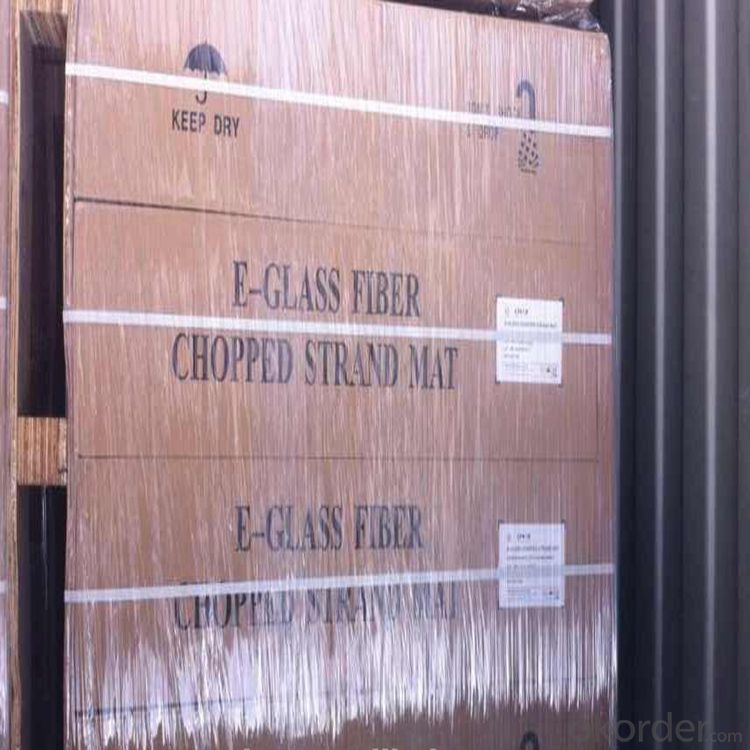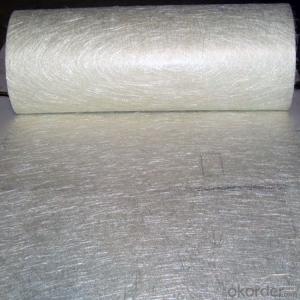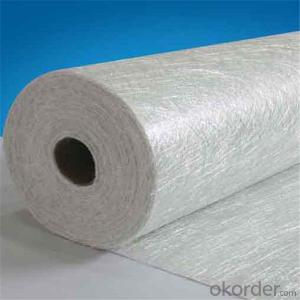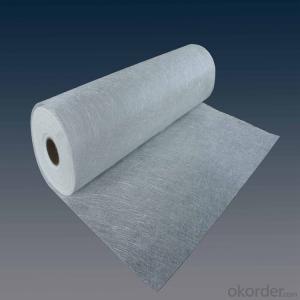Chopped Strand Mat Fiberglass Reinforced Raw Materials
- Loading Port:
- China main port
- Payment Terms:
- TT OR LC
- Min Order Qty:
- 1 kg
- Supply Capability:
- 5000 kg/month
OKorder Service Pledge
OKorder Financial Service
You Might Also Like
Product Description:

Surfacing Tissue mainly used in the surface layers of FRP products. It features even Fiber distribution, soft feel, level and smooth fiber surface, less glue content, quick resin soak and good pattern fitness. It can improve the product surface property on corrosion resistance, compressive strength, seepage resistance, and longer service life. It is also suitable for spraying; pattern pressing and other FRP pattern technology.
Surfacing Tissue mainly used in the surface layers of FRP products. It features even Fiber distribution, soft feel, level and smooth fiber surface, less glue content, quick resin soak and good pattern fitness. It can improve the product surface property on corrosion resistance, compressive strength, seepage resistance, and longer service life. It is also suitable for spraying; pattern pressing and other FRP pattern technology.
Product Features:
Fast breakdown in styrene
Fiber dispersed evenly
Low binder content
Superior acid corrosion resistance
Specifications:
Item | Over Density | Moisture Content | Chop Density | Polyester Yarn | Width |
(g/m2) | (%) | (g/m2) | (g/m2) | (mm) | |
EMK300 | 309.5 | ≤0.15 | 300 | 9.5 | 50-3300 |
EMK380 | 399 | 380 | 19 | ||
EMK450 | 459.5 | 450 | 9.5 | ||
EMK450 | 469 | 450 | 19 | ||
EMC0020 | 620.9 | 601.9 | 19 | ||
EMC0030 | 909.5 | 900 | 9.5 |
Product Packaging:
Each Surface Tissue is wound onto a paper tube which has an inside diameter of 76mm and the mat roll has a diameter of 330mm. The mat roll is wrapped up with plastic film,and then packed in a cardboard box or wrapped up with kraft paper. The rolls can be vertically or horizontally placed. For transportation, the rolls can be loaded into a cantainer directly or on pallets.

Product Storage:
Unless otherwise specified, Chopped Strand Mat should be stored in a dry, cool and rain-proof area. It is recommended that the room temperature and humidity should be always maintained at 15℃~35℃ and 50%~75% respectively.
Company Information
CNBM (China National Building Material) Group is the largest comprehensive building materials group in China that in integrate scientific research, manufacturing and logistics into one entity. The largest building materials and equipment specialists in China. Upon State Council approval, today CNBM owned more than 300 subordinate manufacturing factories and servicing companies. There are 6 fully owned public listed companies and 11 partially owned with substantial shares public listed companies. In many of these fields, CNBM is playing the leading role in the building industry in the country.

- Q: Can fiberglass chopped strand be used in the manufacturing of sports equipment?
- Yes, fiberglass chopped strand can be used in the manufacturing of sports equipment. It is commonly used as a reinforcement material in composite structures due to its lightweight, high strength, and excellent impact resistance properties. Fiberglass chopped strand can be incorporated into various sports equipment such as tennis rackets, hockey sticks, surfboards, and bicycle frames to enhance their performance and durability.
- Q: How does the density of fiberglass chopped strand composites compare to other materials?
- The density of fiberglass chopped strand composites is relatively low compared to other materials. Fiberglass composites are made by embedding chopped strands of fiberglass within a matrix material, such as resin. The density of the composite will depend on the specific matrix material used, but in general, fiberglass composites have a lower density than metals, such as steel or aluminum. This low density is one of the main advantages of fiberglass composites, as it allows for lightweight and high-strength applications. Compared to wood or concrete, fiberglass chopped strand composites also tend to have a lower density. However, it is important to note that the density can vary depending on the specific formulation and manufacturing process used for the fiberglass composites.
- Q: Does fiberglass chopped strand improve the chemical resistance of composite materials?
- The chemical resistance of composite materials can be enhanced through the incorporation of fiberglass chopped strand. Fiberglass possesses exceptional chemical resistance due to its inert nature and lack of reactivity with most chemicals. When utilized as a reinforcement in composite materials, particularly in fiberglass-reinforced plastics (FRPs), the chopped strand contributes to an overall improvement in chemical resistance. By reinforcing the composite matrix, the chopped strand augments its strength and durability. This reinforcement effectively impedes the infiltration and absorption of chemicals, thereby heightening the composite material's resistance to chemical attacks. Moreover, the fiberglass chopped strand can function as a protective barrier, preventing the chemicals from reaching the underlying layers of the composite and causing harm. To further enhance the chemical resistance of composite materials, it is crucial to select the appropriate type and sizing of the fiberglass chopped strand. Different types of fiberglass, such as E-glass, S-glass, and boron fibers, offer varying degrees of chemical resistance. Additionally, the application of a specific sizing or coating to the chopped strand can also bolster its chemical resistance properties. Nevertheless, it is important to acknowledge that while the incorporation of fiberglass chopped strand can enhance the chemical resistance of composite materials, it does not render them completely impervious to all types of chemicals. Certain aggressive chemicals, such as potent acids or bases, may still elicit damage to the composite, even with the presence of fiberglass chopped strand. Consequently, it is imperative to consider the precise chemical environment in which the composite will be utilized and accordingly select suitable materials and reinforcements.
- Q: What are the typical cost savings associated with using fiberglass chopped strand composites?
- The typical cost savings associated with using fiberglass chopped strand composites include reduced material costs, lower labor expenses due to easier handling and processing, decreased transportation costs due to lightweight nature, and longer product lifespan resulting in reduced maintenance and replacement costs.
- Q: Does fiberglass chopped strand improve the sound insulation properties of composite materials?
- Composite materials can benefit from the inclusion of fiberglass chopped strand, as it has the ability to improve their sound insulation properties. Fiberglass, known for its exceptional acoustic characteristics, is frequently utilized in soundproofing applications due to its capacity to absorb and dampen sound waves. By incorporating fiberglass chopped strands into composite materials, their sound insulation capabilities are enhanced, resulting in reduced sound transmission through the material. The delicate fibers of fiberglass assist in dissipating and absorbing sound energy, leading to decreased noise transmission and improved sound insulation. Moreover, fiberglass chopped strand also enhances the structural integrity of composite materials, rendering them more efficient in the blocking and absorption of sound waves. All in all, the addition of fiberglass chopped strand to composite materials significantly augments their sound insulation properties, making them suitable for a wide range of applications, including automotive, aerospace, and building construction.
- Q: Can fiberglass chopped strand be used in the production of consumer goods?
- Yes, fiberglass chopped strand can be used in the production of consumer goods. It is commonly utilized in various industries such as automotive, construction, and marine for manufacturing products like pipes, tanks, boats, and vehicle parts. The lightweight and durable nature of fiberglass make it suitable for consumer goods production, providing strength and resistance to corrosion.
- Q: Can fiberglass chopped strand be used in construction?
- Yes, fiberglass chopped strand can be used in construction. It is commonly used as a reinforcement material in various construction applications such as concrete, roofing, insulation, and composite panels. It enhances the strength, durability, and fire resistance of the construction materials.
- Q: Is fiberglass chopped strand suitable for applications requiring high impact resistance?
- No, fiberglass chopped strand is not suitable for applications requiring high impact resistance. While fiberglass chopped strand is known for its strength and durability, it does not possess the necessary properties to withstand high levels of impact. It is more commonly used in applications where strength and stiffness are the primary considerations, such as in automotive parts, boats, and construction materials. For applications that require high impact resistance, other materials such as carbon fiber or Kevlar are more suitable options. These materials have superior impact resistance properties and are commonly used in industries such as aerospace, sports equipment, and personal protective equipment.
- Q: Is fiberglass chopped strand compatible with polyester resin?
- Yes, fiberglass chopped strand is compatible with polyester resin. Both materials are commonly used together in various applications such as boat building, automotive parts, and construction. Polyester resin is a popular choice for bonding and reinforcing fiberglass chopped strand because it provides good adhesion, strength, and durability. The resin encapsulates the chopped strands, creating a strong composite material. However, it is important to note that the compatibility also depends on the specific type and brand of fiberglass chopped strand and polyester resin being used, so it is always recommended to check the manufacturer's guidelines and conduct a small-scale test before proceeding with a larger project.
- Q: Can fiberglass chopped strand be used in the production of boat hulls?
- Fiberglass chopped strand is indeed applicable for boat hull production. This reinforcement material, widely utilized in composite materials like boat hulls, is made up of randomly chopped glass fibers that are combined with resin to form a robust and durable composite material. Incorporating fiberglass chopped strand into the production of boat hulls enhances their strength, rigidity, and resistance to impacts, thus enabling them to endure the harsh marine conditions. Moreover, this material can be easily shaped into intricate forms, enabling boat manufacturers to create hulls with specific designs and features. All in all, fiberglass chopped strand is a popular and efficient material employed in boat hull manufacturing.
Send your message to us
Chopped Strand Mat Fiberglass Reinforced Raw Materials
- Loading Port:
- China main port
- Payment Terms:
- TT OR LC
- Min Order Qty:
- 1 kg
- Supply Capability:
- 5000 kg/month
OKorder Service Pledge
OKorder Financial Service
Similar products
Hot products
Hot Searches
Related keywords



























